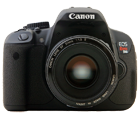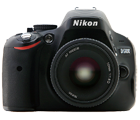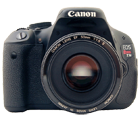The Best Action Lens
Let's get this out of the way first: the best action lens for your digital SLR camera will be EXPENSIVE.
Action photography is very demanding on the camera, lens and photographer, and a second-rate lens is ultimately just going to frustrate you.
On the plus side, once you plunk down a large sum of money for an exceptional action lens, you'll never have to replace it.
Lens Speed
So what is it that makes the best action lenses so expensive?
Two words: maximum aperture.
Every lens has a limit to how wide it can open up and how much light it can let in. This limit is called the maximum aperture.
The maximum aperture of every lens is listed as part of the lens name. For example, a 28-135mm f/4 lens has a maximum aperture of f/4.
The smaller the number, the wider the maximum aperture. In this case, a 28-75mm f/2.8 lets in more light than a 18-55mm f/3.5.
A lens that lets in more light allows you to use faster shutter speeds - the shutter does not have to be open for long periods of time because enough light is passing through the lens to get a correct exposure.
Since lenses with wide maximum apertures let you use faster shutter speeds, they are also commonly called "fast" lenses.
If action photography is your cup of tea, then you're going to need a fast lens.
Telephoto Required
All lenses come in different focal lengths, and this is a measure of how far away you can be from your subject and still get a close-up.
The best action lens is going to fall into the telephoto focal length, which means anywhere between 100 and 300 millimeters.
A telephoto lens will allow you to stand on the sidelines of your favorite sporting event and capture nice close-up shots of the players in action.
But the need for a telephoto lens causes a bit of a problem.
The longer the focal length of a lens, the harder it is for the lens to have a wide maximum aperture.
While it might be fairly straightforward to construct a 200mm lens with a f/5.6 maximum aperture, building the same lens with an f/2.8 maximim aperture (significantly wider) is not so easy.
Fast telephoto lenses use a lot of glass, are very large and heavy, and consequently come with price tags that are not for the faint of heart.
Constant Aperture
Zoom lenses can either have variable or constant maximum aperture.
When a zoom lens has a variable maximim aperture, the maximum opening of the lens changes as you zoom.
An 18-55mm f/3.5-5.6 lens has a maximum aperture of f/3.5 at the 18mm setting, but that narrows down to f/5.6 at the 55mm setting.
By comparison, a zoom lens with a constant maximum aperture never changes, no matter how much you zoom. You can distinguish these lenses because they only list one number for maximum aperture (i.e. 28-135mm f/4).
The problem with variable maximum aperture lenses is that every time you zoom your exposure settings change.
Since the lens lets in less light at the telephoto setting, this affects the shutter speed that you are using (it slows down, to let in more light and create a balanced exposure).
Since you really want your shutter speed to be consistent when you're taking action photos, the best action lens should have a constant maximim aperture.
The Best Action Lenses
All lenses are manufacturer-specific, and the best lens for a Canon camera won't be the same as for a Nikon, Pentax or Olympus digital SLR.
Since the lenses that I have listed below are telephoto zooms with wide constant maximum apertures, they do cost a LOT of money.
Just realize that the money that you spend on a lens like this will pay off once you've captured some exceptional action shots with it.
CANON: 70-200mm f/2.8L IS USM
NIKON: 70-200mm f/2.8G ED-IF AF-S VR
SONY: 70-200mm f/2.8 G-Series
| image not available |
Cost: $TBD
Filter Size: 77
Size: 7.75 x 3.5in (196.5 x 87mm)
Weight: 47oz (1,340g)
|
|
| Even though this lens for the Sony ALPA digital SLR camera line isn't available yet, when it comes out, it's going to be your best option for action photography, since it meets many of the requirements that the other lenses on this page fulfill. | ||
PENTAX: Sigma 70-200 f/2.8 APO EX DG HSM
OLYMPUS: Zuiko 50-200mm f/2.8-3.5 E-ED
| Digital SLR Home |








